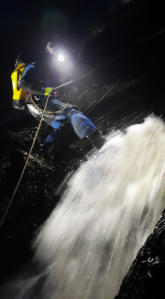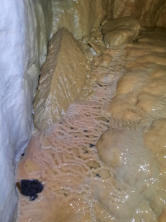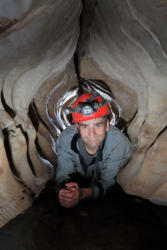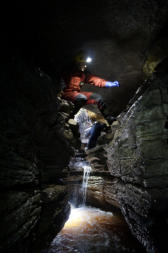


© 2025 SpeleoCanada


What is Caving?
Cave exploring, or simply ‘caving’, is the recreational
companion of speleology, which is the scientific study
of natural caves. Sometimes jokingly referred to as
“mountain climbing inside out in the dark”, caving can
be pursued simply as a challenging and rewarding
sport. However, responsible caving demands a
considerable degree of preparation, skill and
conservation awareness, as fragile cave resources can
easily be irreparably damaged.
Take nothing but photographs
Leave no trace
Kill nothing but time
Most long-time cavers are motivated by the lure of
exploring where no one has gone before and mapping
(surveying) their discoveries. These explorations open
the way for more detailed study of caves and their
resources in sciences such as hydrology, mineralogy,
biology and paleontology. Unlike many other purely
recreational pursuits, caving thus becomes “a sport in
the service of science”.
Caving enthusiasts tend to call themselves “cavers“,
rather than “spelunkers”, a term often used by non-
cavers.
While technically correct, the term “spelunker” has over
time developed an unfortunate connotation of
inexperience or lack of proper training & preparation.
There is a saying in the cave rescue organizations that
“cavers rescue spelunkers”.
Go Caving?
If you are interested in recreational caving, please
consider the following advice.
Caves are many things to many people. To some they
offer a beautiful and mysterious underground world to
explore. To others they are frightening and ominous. To
all, they are potentially dangerous. As with any
adventure sport, a basic level of fitness, proper
equipment, training, a degree of caution and a little
common sense greatly increase the chances for a safe,
enjoyable experience.
Canada has a wide variety of cave environments, some
of which are easy to access and progress through, and
some that are extremely challenging. Especially in the
Rockies, relatively few are suitable for novice cavers.
Many have vertical drops and other hazards that require
experience and specialized equipment to negotiate
safely. Although they may look like the gear that rock
climbers use, caving ropes, equipment and techniques
are specialized and have been developed independently
to provide an acceptable margin of safety specific to
cave conditions. Technical cave equipment should
never be used without proper instruction from an
experienced caver.
How do I get into caving?

Speleo Canada
Luke Nelson - Alberta
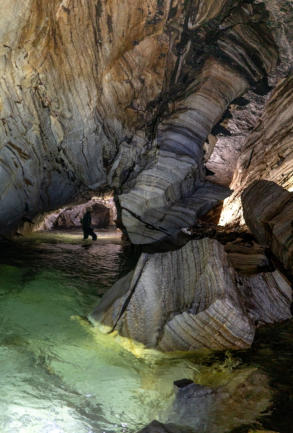
Adam Walker
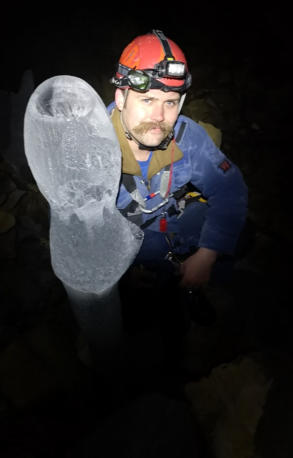
Ken Smith



© SpeleoCanada 2024
What is Caving?
Cave exploring, or simply
‘caving’, is the recreational
companion of speleology,
which is the scientific study
of natural caves. Sometimes
jokingly referred to as
“mountain climbing inside
out in the dark”, caving can
be pursued simply as a
challenging and rewarding
sport. However, responsible
caving demands a
considerable degree of
preparation, skill and conservation awareness,
as fragile cave resources can easily be
irreparably damaged.
Take nothing but photographs
Leave no trace
Kill nothing but time
Most long-time cavers are motivated by the
lure of exploring where no
one has gone before and
mapping (surveying) their
discoveries. These
explorations open the way
for more detailed study of
caves and their resources in
sciences such as hydrology,
mineralogy, biology and
paleontology. Unlike many
other purely recreational
pursuits, caving thus becomes “a sport in the
service of science”.
Caving enthusiasts tend to call themselves
“cavers“, rather than “spelunkers”, a term
often used by non-cavers.
While technically correct, the term
“spelunker” has over time developed an
unfortunate connotation of inexperience or
lack of proper training & preparation. There is
a saying in the cave rescue organizations that
“cavers rescue spelunkers”.
Go Caving?
If you are interested in recreational caving,
please consider the
following advice.
Caves are many things to
many people. To some they
offer a beautiful and
mysterious underground
world to explore. To others
they are frightening and
ominous. To all, they are
potentially dangerous. As
with any adventure sport, a
basic level of fitness, proper equipment,
training, a degree of caution and a little
common sense greatly increase the chances
for a safe, enjoyable experience.
Canada has a wide variety of cave
environments, some of which are easy to
access and progress through, and some that
are extremely challenging.
Especially in the Rockies,
relatively few are suitable
for novice cavers. Many
have vertical drops and
other hazards that require
experience and
specialized equipment to
negotiate safely. Although
they may look like the
gear that rock climbers
use, caving ropes, equipment and techniques
are specialized and have been developed
independently to provide an acceptable
margin of safety specific to cave conditions.
Technical cave equipment should never be
used without proper instruction from an
experienced caver.
How do I get into
caving?
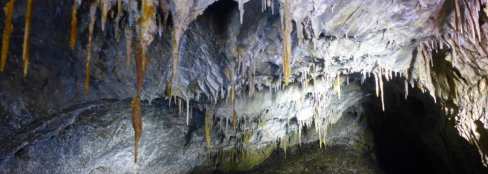

Speleo Canada
